Online Course
NDNP 804 - Theory for Evidence-Based Practice
Module 8: Theory, Model or Framework Identification
Informatics Theories
Theories and frameworks are an important part of applying nursing informatics to practice, education, leadership, and research. They can also be used to support DNP projects and research studies. The following includes several theories that can be used to support inquiry focused on nursing informatics.
Cognitive Engineering Theories - contend that the interaction between the context and the individual is more likely to predict decision-making, perception and other cognitive variables.
- Naturalistic Decision Making (NDM) (Klein, 1997; Kushniruk & Patel, 2004); Control Theory (Åström & Murray, 2008).
- Situational Awareness (SA) combines the cognitive processes of orientation, attention, categorization or sense-making and planning into three levels of performance, critical to performance of a human in complex environments. Endsley and Garland (2000) include these levels:
- perception
- comprehension
- projection
Information Theories – degree of uncertainty in messages is a function of capacity of the system to transmit messages given noise and entropy (Shannon, 1948; Shannon & Weaver, 1949).
- (Unnamed) published by Krippendorf (1986) – three levels of analysis: technical, semantic, effectiveness
- Information Foraging Theory – humans use similar patterns in searching for information (e.g., web searching) as do animals searching for food because each is goal-directed and involved costs (Pirolli, 2007; Piroli & Card, 1999).
Information Technology Theories – these compile several existing theories, for example information theory and Diffusion of Innovations.
- Information System Success – multi-factorial model with empirical support (DeLone & McLean, 2003). Three model includes levels of information:
- technical (accuracy and efficiency of the communication system)
- semantic (communicating meaning)
- effectiveness (impact on receiver)
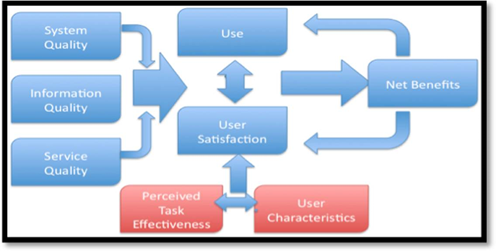 Figure 1. A Model of Information System Success adapted from DeLone and
Figure 1. A Model of Information System Success adapted from DeLone and
McLean (2003).
- Unified Theory of Acceptance and Use of Technology (UTAUT)(Venkatesh, Morris, Davis, & Davis, 2003). UTAUT explains the users’ intentions to use an information system as a function of performance expectancy or self-efficacy beliefs, effort expectancies, social influence and facilitating conditions. The theory integrates Social Cognitive Theory (Bandura, 1989), Theory of Reasoned Action (Fishbein & Ajzen, 1975), and Diffusion of Innovations Theory (Rogers, 1983).
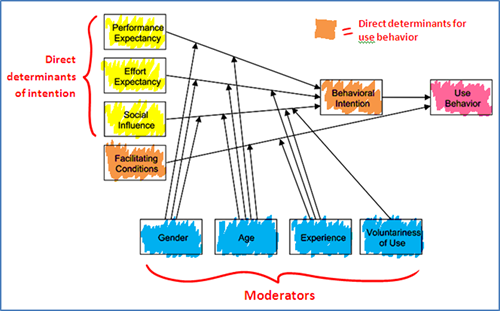
Figure 2. An Example of UTAUT
Health IT Product or Program Implementation Models - generalized, large-scale implementation theories that are focused on performance improvement and institutional-wide change.
- Precede/Proceed Model or Predisposing, Reinforcing, and Enabling Constructs in Educational Diagnosis and Evaluation (Green & Kreuter, 2005). The model examines the design of effective healthcare interventions and evaluates program outcomes. Based on motivation, the model includes three categories of variables:
- predisposing factors that lay the foundation for success (e.g., electronic health records or strong leadership)
- reinforcing factors that follow and strengthen behavior (e.g., incentives and feedback)
- enabling factors that activate and support the change process (e.g., support, training, computerized reminders and templates or exciting content)
The model is used for other purposes besides Health IT including educational program evaluation.
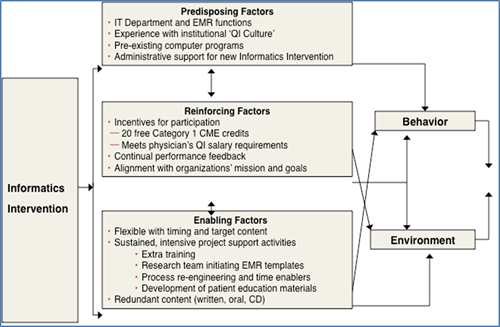
Figure 3. An Adaptation of the Precede-Proceed Model from Green and
Kreuter (2005) for a Health IT Product - Promoting Action on Research Implementation in Health Services (PARIHS) (Stetler, Damschroder, Helfrich, & Hagedorn, 2011). The model includes three areas:
- Evidence (establishing the efficiency and effectiveness of the intervention through expert contribution, literature reviews, surveys, usability testing, and Cognitive Task Analyses)
- Context (enhancing leadership support and integrating with the culture through focus groups and interviews
- Facilitation of the implementation process (skill level and role of facilitator in promoting action as well as frequency of supportive interactions)
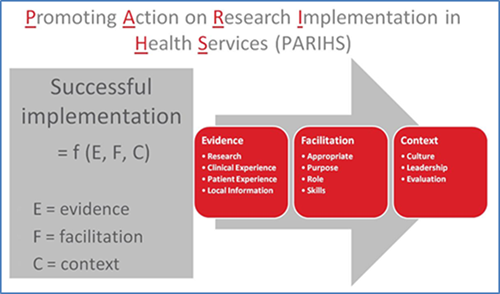 Figure 4. The PARiHS Model (Kitson et al., 2008)
Figure 4. The PARiHS Model (Kitson et al., 2008)
- Reach Effectiveness Adoption Implementation Maintenance (RE-AIM) (Gaglio & Glasgow, 2012; Glasgow, Vogt, & Boles, 1999). The model is designed to address the significant barriers associated with implementation of any new intervention and is particularly useful for informatics to identify barriers in product/program implementation.
Program Theory models – practical guides for evaluation of Health IT and other products.
Logic Model. A logic model is a representation of components and mechanisms of the program (W.K. Kellogg Foundation, 2004). The Logic Model starts with a category of “Inputs” which include staff, resources, prior success and stakeholders. In Health IT, the inputs are the programs, software, the IT staff, hardware, networks and training. “Outputs” include the activities that are going to be conducted, such as training, implementation, software design and other computer activities. Many examples can be retrieved by browsing on the web for the term Logic Model.
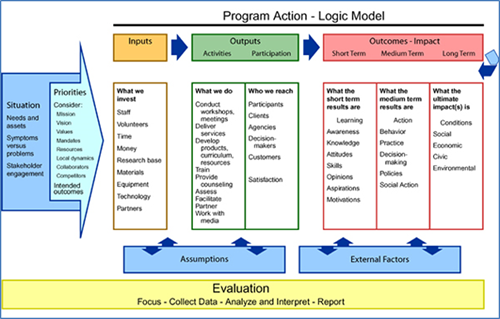
Figure 5. Example of a Logic Model Structure retrieved from http://www.uwex.edu/ces/pdande/evaluation/evallogicmodel.html
Human-Computer Interaction Models/Frameworks - depict individual or group interactions with computers/technology embedded in a context (depending upon the model). Includes salient components such as goals, tasks, interaction (Ammenwerth, Iller, & Mahler, 2006; Borycki, Kushniruk, Bellwood, & Brender, 2012); Despont-Gros, Mueller, & Lovis, 2005; Hollnagel & Woods, 2005; Johnson, Johnson, & Zhang, 2005; Staggers, 2001; Yusof, Stergioulas, & Zugic, 2007; Zhang & Butler, 2007) . Select models are below:
- FITT - the fit between an individual, tasks and technology with the elements connected by interactions and influences.(Ammenwerth et al., 2006)
- UFuRT renamed TURF in 2011 – elements of import are spelled out in this acronym: User, Function, Representation, and Task. System knowledge is distributed across multiple users having differences in expertise and cognitive characteristics. It includes a task analysis portion to describe steps in tasks and interactions (Zhang & Butler, 2007)
- Unnamed - A framework for employing usability methods to redesign a fielded system (>Johnson et al., 2005)
- Technology-induced error (Borycki, Kushniruk, Bellwood, & Brender, 2012)
- HIT adoption and HCI model (Despont-Gros, Mueller, & Lovis, 2005)
- Joint cognitive systems (Hollnagel & Woods, 2005) - sociotechnical systems or complex technologies are embedded within social systems. JCS is a cyclical model called contextual control model or CoCom with elements: event, modifies, constructs, determines, acts, and produces. Users and context are major components of the model.
- Health Human-Computer Interaction Framework - builds upon early work by Staggers and Parks (1992, 1993) describing nurse-computer interaction, expanded in 2001 to include groups of providers and interactions with patients (Staggers, 2001; 2013a, 2013b).
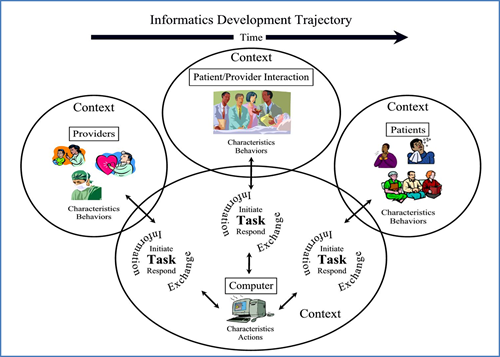
Figure 6. Health Human-Technology Interaction Framework (Staggers, 2001, 2013)
References
Ammenwerth, E., Iller, C., & Mahler, C. (2006). IT-adoption and the interaction of task, technology and individuals: A FIT framework and a case study. BioMed Central, 6(3), 1-13.
Åström, K., & Murray, R. (2008). Feedback systems: An introduction for scientists and engineers. Princeton University Press. ISBN 0-691-13576-2.
Bandura, A. (1989). Human agency in social cognitive theory. American Psychologist, 44(9), 1175-1184.
Borycki, E. M., Kushniruk, A. W., Bellwood, P., & Brender, J. (2012). Technology-induced errors. The current use of frameworks and models from the biomedical and life sciences literatures. Methods of Informatics in Medicine, 51(2), 95-103. doi: 11-02-0009 10.3414/ME11-02-0009
DeLone, W., & McLean, E. (2003). The DeLone and McLean Model of Information Systems success: A ten-year update. Journal of Management Information Systems, 19(4), 9-30. Retrieved from http://www.asiaa.sinica.edu.tw/~ccchiang/GILIS/LIS/p9-Delone.pdf
Despont-Gros, C., Mueller, H., & Lovis, C. (2005). Evaluating user interactions with clinical information systems: aAmodel based on human-computer interaction models. Journal of Biomedical Informatics, 38(3), 244-255. doi: S1532-0464(04)00171-6 10.1016/j.jbi.2004.12.004
Endsley, M., & Garland, D. (2000). Situation awareness analysis and measurement. Mahway, NJ: Lawrence Erlbaum Ass.
Fishbein, M., & Ajzen, I. (1975). Belief, attitude, intention, and behavior: An introduction to theory and research. Reading, MA: Addison-Wesley.
Gaglio , B., & Glasgow, R. (2012). Evaluation approaches for dissemination and implementation research. In R. Brownson, G. Colditz & E. Proctor (Eds.), Dissemination and implementation research in health: Translating science to practice. (pp. 327-356). New York: Oxford University Press.
Glasgow, R., Vogt, T., & Boles, S. (1999). Evaluating the public health impact of health promotion interventions: the RE-AIM framework. American Journal of Public Health, 89(9), 1922-1927.
Green, L., & Kreuter, M. (2005). Health program planning: An educational and ecological approach. (4th Ed). Mountain View, CA: Mayfield Publishers.
Hollnagel, E., & Woods, D. (2005). Joint cognitive systems: Foundations of cognitive systems engineering. Boca Raton: Yaylor & Francis.
Johnson, C. M., Johnson, T. R., & Zhang, J. (2005). A user-centered framework for redesigning health care interfaces. Journal of Biomedical Informatics, 38(1), 75-87. doi: S1532-0464(04)00153-4 [pii] 10.1016/j.jbi.2004.11.005
Kitson, A. L., Rycroft-Malone, J., Harvey, G., McCormack, B., Seers, K., & Titchen, A. (2008). Evaluating the successful implementation of evidence into practice using the PARiHS framework: theoretical and practical challenges. Implementation Science, 3, 1. doi:10.1186/1748-5908-3-1
Klein, G. (1997). An overview of natural decision making applications. In C. E. Zsambok & G. Klein (Eds.), Naturalist Decision Making. Mahwah, NJ: Lawrence Erlbaum Associates.
Krippendorf, K. (1986). Information theory: Structural models for qualitative data. Thousand Oaks, CA: Sage Publications.
Kushniruk, A. W., & Patel, V. L. (2004). Cognitive and usability engineering methods for the evaluation of clinical information systems. Journal of Biomedical Informatics, 37(1), 56-76.
Nelson, R., & Staggers, N. (2013). Health care informatics: An interprofessional approach. St. Louis: Elsevier.
Pirolli, P. (2007). Information foraging theory: Adaptive interaction with information. Oxford: Oxford University Press: Oxford Series in Human-Technology Interaction.
Pirolli, P., & Card, S. (1999). Information foraging. Psychological Review, 106(4), 643-675.
Rogers, E. (1983). Rogers, Everett M. (1983). Diffusion of Innovations. New York: Free Press.ISBN 978-0-02-926650-2
Shannon, C. (1948). A mathematical theory of communication. Bell System Technical Journal, 27, 379–423 & 623–656.
Shannon, C., & Weaver, W. (1949). The mathematical theory of communication.Urbana, IL: University of Illinois Press.
Staggers, N. (2001). Human-computer interaction. In S. Englebardt & R. Nelson (Eds.), Information technology in health care: An interdisciplinary approach (pp. 321-345). St. Louis: Elsevier.
Staggers, N. (2013a). Improving the usability of health informatics applications. In T. Hebda & P. Czar (Eds.), Handbook of Informatics for Nurses and Health Professionals (pp. 170-193). Upper Saddle River, NJ: Pearson Education.
Staggers, N. (2013b). Improving the user experience in Healht IT. In R. Nelson, & N. Staggers (Eds), Health Informatics: An Interprofessional Approach. St. Louis: Elsevier.
Staggers, N., & Parks, P. L. (1992). Collaboration between unlikely disciplines in the creation of a conceptual framework for nurse-computer interactions. Proceedings of the Annual Symposium of Computer Applications in Medical Care, 661-665.
Staggers, N., & Parks, P. L. (1993). Description and initial applications of the Staggers & Parks Nurse-Computer Interaction Framework. Computers in Nursing, 11(6), 282-290.
Stetler, C. B., Damschroder, L. J., Helfrich, C. D., & Hagedorn, H. J. (2011). A Guide for applying a revised version of the PARIHS framework for implementation. Implementation Science, 6, 99. doi:1748-5908-6-99 Retrieved from https://implementationscience.biomedcentral.com/articles/10.1186/1748-5908-6-99
Venkatesh, V., Morris, M., Davis, G., & Davis, F. (2003). User acceptance of information technology: Toward a unified view. MIS Quarterly, 27(3), 425-478.
W.K. Kellogg Foundation. (2004). Using logic models to bring together planning, evaluation, and action: Logic Model development guide. W.K. Kellogg Foundation.
Yusof, M. M., Stergioulas, L., & Zugic, J. (2007). Health information systems adoption: Findings from a systematic review. Studies of Health, Technology, Informatics, 129(Pt 1), 262-266.
Zhang, J., & Butler, K. A. (2007). UFuRT: A work-centered framework and process for design and evaluation of information systems. Paper presented at the Proceedings of HCI International 2007, Beijing, China.
This topic is derived from the following work:
Staggers, N. (2013). Improving the user experience in Healht IT. In R. Nelson, & N. Staggers (Eds), Health Informatics: An Interprofessional Approach. St. Louis: Elsevier.
This website is maintained by the University of Maryland School of Nursing (UMSON) Office of Learning Technologies. The UMSON logo and all other contents of this website are the sole property of UMSON and may not be used for any purpose without prior written consent. Links to other websites do not constitute or imply an endorsement of those sites, their content, or their products and services. Please send comments, corrections, and link improvements to nrsonline@umaryland.edu.